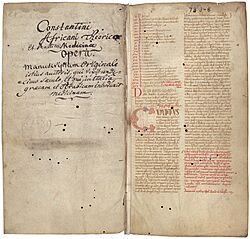Liber pantegni facts for kids
Quick facts for kids Liber pantegni |
|
|---|---|
| The first part, Pantegni pars prima theorica (lib. I-X), is kept at the National library of the Netherlands, KB 73 J 6 | |

Eleventh-century manuscript version of the Liber pantegni, National library of the Netherlands
|
|
| Type | Codex |
| Date | 11th century, prior to 1086 |
| Place of origin | Monte Cassino, Italy |
| Language(s) | Latin, translated from Arabic |
| Compiled by | Constantinus Africanus |
| Dedicated to | Abbot Desiderius of Monte Cassino(1027-1087), before he became Pope Victor III.
|
| Material | Parchment |
| Size | The first part, Pantegni pars prima theorica (lib. I-X) has 89 folios measuring 235 x 128 mm. Text block: 189 × 98 mm |
| Format | 2 columns, 62 lines |
| Script | Littera pregothica |
| Additions | Various recipes and other medical texts were added to the front (folios Ir-IIv) and back (87v-89r) of the manuscript in 12th and 13th century. |
| Exemplar(s) | This codex is in large parts a translation from the Arabic of the Kitab al-Malaki (Royal Book) of Ali ibn al-Abbas al-Majusi (Ali Abbas, died after 977). |
| Discovered | The earliest known copy, which had first been studied in 1909, was recognized in 2010 as having been made at Monte Cassino during Constantine's lifetime. |
| Accession | Description of the 11th century copy in the catalogue of the KB |
| Other | Digitized version, website KB |
The Liber pantegni is a very old and important medical book. Its name means "all medical arts" in Greek. It was put together by a scholar named Constantinus Africanus around the year 1086. Many people consider it the first complete medical textbook written in Latin.
Before this book, there were other Latin medical writings. But the Liber pantegni was special because it brought together a huge amount of knowledge. It covered topics like how the body works (anatomy), how living things function (physiology), and how to treat illnesses (therapeutics). Constantine dedicated his work to Abbot Desiderius of Monte Cassino. Desiderius later became Pope Victor III. In 2010, experts found the oldest known copy of the Liber pantegni. It was made at Monte Cassino under Constantine's own guidance.
Contents
What is the Liber Pantegni?
The Liber pantegni is a collection of medical ideas from ancient Greece and the Islamic world. Most of it is a translation from an Arabic book called the Kitab al-Malaki, or "Royal Book." This original book was written by Ali ibn al-Abbas al-Majusi.
The Kitab al-Malaki was divided into two main parts:
- Theorica: This part dealt with the theory of medicine.
- Practica: This part focused on practical medical treatments.
Each of these parts had ten smaller books within them.
The Theorica Part
Constantine translated the entire Theorica part of the "Royal Book." This means he brought all ten books about medical theory into Latin.
The Practica Part and Its Challenges
However, Constantine's translation of the Practica part was never fully finished. Some historians think this might be because some of his books were damaged. He brought these books with him from North Africa to Italy.
At first, only a small part of the Practica was available. This included:
- Book 1: About healthy living.
- Part of Book 2: About simple medicines.
- Part of Book 9: About surgery.
Because the surgery section was so useful, two other translators finished Book 9 in 1114-15.
More Discoveries About the Practica
Later research by Monica H. Green and Iolanda Ventura showed that Constantine might have translated more of the Practica than people first thought. They found copies of Books 6 and 7. These books covered diseases of the chest and stomach.
Ventura also found a copy of Book 10, which was about compound drugs. She also confirmed that Constantine finished the second half of Book 2, which was about simple medicines.
Completing the Practica
So, by the 12th century, many parts of the Practica were available. But they were scattered and not always easy to understand. Someone, whose name we don't know, worked to put all these pieces together. This editor combined Constantine's translations with parts of his other works.
By the early 13th century, a "complete" version of the Practica was made. This created a new, twenty-book Pantegni (10 books of Theorica + 10 books of Practica). This full version was even printed in 1515.
Impact and Influence
In 1127, Stephen of Antioch created a new translation of the "Royal Book." He thought Constantine's version was incomplete and not very good. Stephen's version was called the Liber regalis dispositionis.
However, Constantine's Liber pantegni became much more popular and important. Over 100 copies of Constantine's book still exist today. Stephen's book, on the other hand, only has eight surviving copies.
The Liber pantegni was used by many doctors and writers as a source of information. For example, the section on how humans reproduce was copied and used for hundreds of years. This shows how influential Constantine's work was in the history of medicine.
Impression of the manuscript (Koninklijke Bibliotheek)







